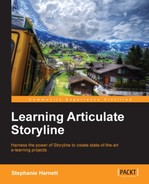There are many ways to boost productivity when using Storyline. Your best bet will be to approach development from the point of view of what's really necessary and avoid creating more complexity than what's called for. Often the most elegant solution is the simplest one.
Here are 10 common methods to boost your productivity with Storyline:
- Become a master formatter. This means using shortcut keys and automating where you can. Here are some examples:
- When you need to apply formatting to multiple objects over multiple layers or slides, double-click on the Format Painter option. This lets you to continue applying formatting until you click anywhere outside the slide.
- Need to apply a trigger to multiple objects? Copy the trigger then select all of the objects and click on the Paste button in the Trigger panel. All you need to do now is make slight adjustments to each instead of creating each trigger from scratch.
- You can also use Duplicate or Ctrl + D to quickly copy objects. For example, you might have multiple instances of the same interaction on a slide, perhaps a tabbed interaction. To set up another fully working instance, you can select all the objects that make up the interaction and then duplicate the elements and make slight adjustments. Remember that Ctrl + A is a shortcut key for selecting all of the elements on a slide.
- If you use a shape effect for a lot of the shapes in a project, such as fills, outlines, and alignment, why repeat formatting over and over again every time you insert a new shape when you can right-click on a shape, button, or caption and choose Set as Default. Next time you use one of these elements, it will come preformatted using your most frequently used settings.
- Size your graphics before importing them into Storyline. You want crisp, clear images. If you resize an image in Storyline, it will become fuzzy since Storyline works only with raster graphics, not scalable vector graphics. Note that the maximum size for an image in Storyline is 2048 x 2048 pixels.
- Study the shortcut keys that are listed in the Appendix of this book and get in the habit of using them for most tasks. This seems minor but it will save a lot of time. It's also worthwhile to customize the Quick Access toolbar so that features you commonly use are just a click away.

- Place the audio and video objects in once, then copy and paste when you need to use the same clips on other slides. It's faster than importing, particularly using shortcut keys. The bonus is that Storyline does not increase the file size, it recognizes the duplicates as copies whereas importing each time increases the file size and treats each instance as a unique object, consuming memory, file space, and additional to publishing time.
- Keep the trigger logic simple and well planned. Consistently organize them from slide-to-slide so it's easier to interpret and edit.
- Use short variable names that are descriptive with logical sequencing and numbering. It's much easier to see short variable names in various displays and drop-down menus.
- Get into the habit of naming the objects in the timeline, again using short names that are meaningful. This will speed up production by consuming less of your time trying to figure out which object is which.
- Leverage templates whenever you can. There are numerous ways you can do this:
- Use the Save As... feature in the Articulate menu to save a projects as a Storyline template. This saves not only the look and feel, interactions and player set up, but also glossary and resource information. This is a great technique when creating multiple courses that are part of a series.
- If you have a single activity that you want to re-use, save it by itself in a Storyline file and then Import the slide(s) into other projects. This speeds up production time because you are re-using, not re-creating, you work with the added bonus that the interaction comes already error-free and tested.
- Make use of Master Slides to automate custom navigation. Set up your navigation buttons and links once on a master slide rather than duplicate on each individual slide.
- Use cue points to synchronize animations. It's a simple feature but a time saver. Clicking on the Play button in the timeline plays back the slide animations and audio track. Pressing C on the keyboard creates a cue point as you listen to the audio. Later, you can align objects and animations to these markers.
- Keep daily versions, if you're working on things daily or weekly, if it's upkeep. Use a consistent naming convention, for example, projectname-v001, -v002, and so on.
- Preview often and publish frequently to check your progress. Look for design inconsistency issues, functional errors, and navigation problems on more than one monitor and in more than one browser. This will go a long way in catching technical or design issues early in the process, otherwise you'll have to apply changes to more slides/scenes later, which will slow down your productivity and increase your risk of errors.
- Take the time to get to know where the limitations are with Storyline, what works well and not so well. Document tips and best practices and share it with your team. It's a continual learning process and when shared, boosts the productivity of the entire team.
- Save your projects often. There is no autosave in Storyline.
..................Content has been hidden....................
You can't read the all page of ebook, please click here login for view all page.
